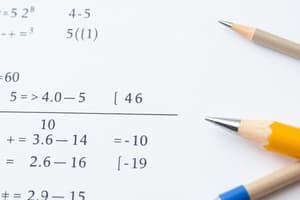Podcast
Questions and Answers
Which of the following is NOT a typical responsibility of the operating system related to resource management?
Which of the following is NOT a typical responsibility of the operating system related to resource management?
- Memory management to allocate and deallocate memory
- CPU scheduling to allocate processor time
- File system management to organize and store files
- Compiler optimization to improve code execution speed (correct)
Consider the following sequence: 2, 6, 12, 20, 30, __. What number logically completes the series?
Consider the following sequence: 2, 6, 12, 20, 30, __. What number logically completes the series?
- 36
- 40
- 44
- 42 (correct)
You're designing a database system and need to ensure the fastest possible search times. Which data structure would be most suitable for indexing?
You're designing a database system and need to ensure the fastest possible search times. Which data structure would be most suitable for indexing?
- AVL Tree (correct)
- Stack
- Queue
- Linked List
A system uses Banker's Algorithm for deadlock avoidance. It has 5 processes and 3 resource types. What information does the system primarily use to determine if a resource allocation is safe?
A system uses Banker's Algorithm for deadlock avoidance. It has 5 processes and 3 resource types. What information does the system primarily use to determine if a resource allocation is safe?
Which of the following is an advantage of using virtual memory?
Which of the following is an advantage of using virtual memory?
In set theory, if A = {1, 2, 3} and B = {3, 4, 5}, what is the cardinality of the union of A and B ( |A ∪ B| )?
In set theory, if A = {1, 2, 3} and B = {3, 4, 5}, what is the cardinality of the union of A and B ( |A ∪ B| )?
Which logic gate is best used to implement the XOR (exclusive OR) function?
Which logic gate is best used to implement the XOR (exclusive OR) function?
What is the primary purpose of using normalization techniques on floating-point numbers in digital systems?
What is the primary purpose of using normalization techniques on floating-point numbers in digital systems?
Consider the equation of a circle: $(x-2)^2 + (y+3)^2 = 16$. What are the coordinates of the center of the circle?
Consider the equation of a circle: $(x-2)^2 + (y+3)^2 = 16$. What are the coordinates of the center of the circle?
You have a binary search tree and need to traverse it to get the elements in sorted order. Which traversal method should you use?
You have a binary search tree and need to traverse it to get the elements in sorted order. Which traversal method should you use?
Flashcards
Thinking and Decision Making
Thinking and Decision Making
Creative thinking, verbal reasoning, finding patterns and assessing figures & diagrams.
Algebra
Algebra
Fundamental operations, expansions, factorization, and equations (linear/quadratic).
Coordinate Geometry
Coordinate Geometry
Distance formula, equation of a line, intersection of lines, and conic sections.
Calculus
Calculus
Signup and view all the flashcards
Operating System
Operating System
Signup and view all the flashcards
Data Structure
Data Structure
Signup and view all the flashcards
Digital Fundamentals
Digital Fundamentals
Signup and view all the flashcards
Set Theory & Probability
Set Theory & Probability
Signup and view all the flashcards
Study Notes
- The Question Paper will have 75 questions.
- All questions will be based on Subject-Specific Knowledge.
- All questions are compulsory.
- The Questions will be Bilingual (English/Hindi).
Thinking and Decision Making
- Involves creative thinking, understanding unfamiliar relationships, verbal reasoning, and finding patterns, trends, and assessment of figures & diagrams.
- Includes Geometrical designs & Identification.
- Selection of related letters / words / numbers / figures
- Identification of odd thing / item out from a group
- Completion of numerical series based on the pattern / logic
- Filling in the blanks of the series based on the numerical pattern and logic of the series
- Syllogisms (logic-based questions), Identification of logic & selection of correct answers based on the logic
Mathematics
- Set Theory entails concepts of sets, including Union, Intersection, Cardinality, and Elementary counting, along with permutations and combinations.
- Probability and Statistics cover basic concepts of probability theory, averages, dependent, and independent events, frequency distributions, measures of central tendencies, and dispersions.
- Algebra focuses on fundamental operations, expansions, factorization, simultaneous linear/quadratic equations, indices, logarithms, and arithmetic, geometric, and harmonic progressions, determinants, and matrices.
- Coordinate Geometry includes rectangular Cartesian coordinates, distance formulae, equation of a line, intersection of lines, pair of straight lines, equations of a circle, parabola, ellipse, and hyperbola.
- Calculus deals with limit of functions, continuous function, differentiation, tangents and normal, examples of maxima and minima. Also covers integration by parts, by substitution, and by partial fraction, definite integrals, and applications to areas.
Computer Topics
- Operating System functions include processes, threads, interprocess communication, concurrency, synchronization, deadlock, CPU scheduling, I/O scheduling, and resource scheduling.
- Deadlock management relies on algorithms like the banker's algorithm.
- Memory management and virtual memory concepts are essential, alongside file systems, I/O systems, DOS, UNIX, and Windows operating systems.
- Data Structures encompass arrays and their applications, sparse matrices, stacks, queues, priority queues, linked lists, trees, forests, binary trees, threaded binary trees, binary search trees, AVL trees, B trees, B+ trees, B* trees and graphs
- Also include data structure for sets, sorting and searching algorithms, hashing, functions, recursion, parameter passing
Digital Fundamentals
- Data types, number systems, conversion methods, complements and fixed/floating point representation, error detection codes.
- Computer Arithmetic includes algorithms for addition, subtraction, multiplication, and division.
- Knowledge of digital computers, logic gates, Boolean algebra, and map simplification.
- Combinational circuits, flip-flops, sequential circuits, integrated circuits, decoders, multiplexers, registers, counters and Memory Unit.
Studying That Suits You
Use AI to generate personalized quizzes and flashcards to suit your learning preferences.




